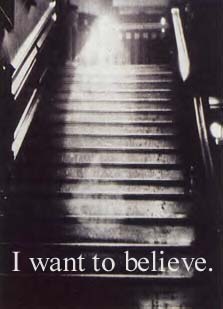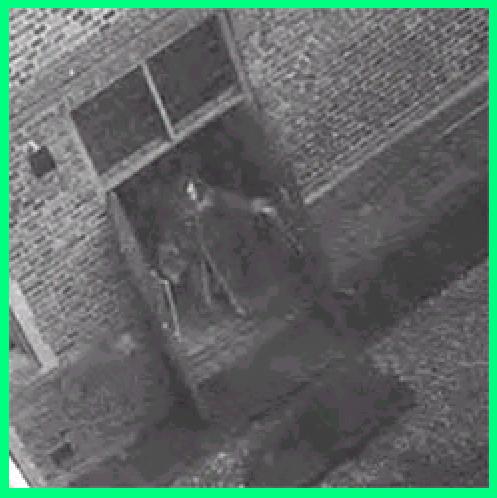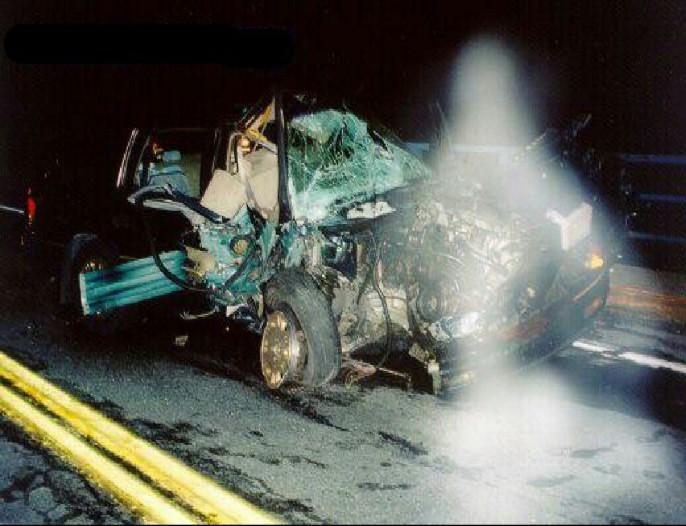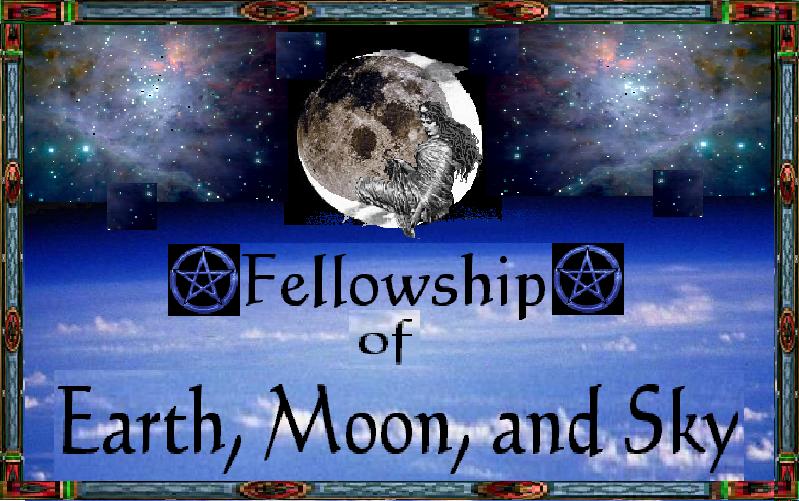
Page Contents:
Cameras Detect Possible Ghostly Presence at Britain's Hampton Court

A supposed figure stands in a doorway at Hampton
Court Palace in southwest London in this image caught on closed
circuit television.
December 19, 2003 LONDON -- Are there ghostly goings-on at Henry VIII's palace, or is that hazy image of a fellow in fancy robes just a bit of Christmas cheer?
Closed-circuit security cameras at Hampton Court Palace, the huge Tudor pile outside London, seem to have snagged an ethereal visitor. Could it be a ghost?
"We're baffled too. It's not a joke. We haven't manufactured it," Vikki Wood, a Hampton Court spokeswoman said when asked if the photo the palace released was a Christmas hoax. "We genuinely don't know who it is or what it is."
Wood said security guards had seen the figure in closed-circuit television footage after checking it to see who kept leaving open one of the palace's fire doors.
In the still photograph, the figure of a man in a robe-like garment is shown stepping from the shadowy doorway, one arm reaching out for the door handle.
The area around the man is somewhat blurred, and his face appears unnaturally white compared with his outstretched hand.
"It was incredibly spooky because the face just didn't look human," said James Faukes, one of the palace security guards.
"My first reaction was that someone was having a laugh, so I asked my colleagues to take a look. We spoke to our costumed guides, but they don't own a costume like that worn by the figure. It is actually quite unnerving," Faukes said.
The palace, built in 1525 on the River Thames about 15 kilometres west of central London, is a popular tourist attraction and some of the guide staff wear costume of the Tudor period.
Wood said she was hoping people would come forward with similar stories and try to explain the figure.
The palace has been the scene of many dramatic royal events and already is supposed to have a few ghosts.
King Henry VIII's third wife, Jane Seymour, died there giving birth to a son, and her ghost is said to walk through one of the cobbled courtyards carrying a candle.
Her son, Edward, had a nurse called Sibell Penn who was buried in the palace grounds in 1562. In 1829 her tomb was disturbed by building work, and around the same time an odd whirring noise began to be heard in the southwest wing of the palace. When workmen traced the strange sounds to a brick wall, they uncovered a small forgotten room containing an old spinning wheel, just like the one Penn used to use.
Henry's fifth wife, Catherine Howard, condemned for adultery, was held at the palace under house arrest before her execution at the Tower of London. An 1897 book about the palace says she was reportedly seen, dressed in white and floating down one of the galleries uttering unearthly shrieks.
The palace was once a prison for King Charles, who later was
beheaded, and then home to his nemesis Oliver Cromwell, who
briefly ruled when Britain was for a short time a republic.
-- by Jack Garland for the Canadian Press
August 19, 2003 -- The ease with which seances can create false memories of supernatural events in the minds of believers has been revealed by a study. In an experiment, up to a third of people who attended a fake seance later "remembered" seeing a table levitate - even though infra-red cameras recorded that it remained grounded to the floor.
Although the volunteers knew that the seance was set up by university scientists, a fifth reported a strange, ghostly presence during the session. Psychologists who conducted the experiments said the results, which are reported in the British Journal of Psychology, showed how seance rituals -- such as the holding of hands and the darkened room -- can create false memories.
Although many of the tricks used by fake mediums and spiritualists have been exposed by magicians seances remain popular today.
The researchers, from Hertfordshire University and Liverpool Hope University College, recreated a classic Victorian "dark room" seance in which participants gather around a table with a medium and hold hands. The table, and several objects on it, are covered with luminous paint and are the only things visible once the lights have been switched off. The 350 volunteers were a mixture of skeptics and believers.
An actor posing as a medium told the group to try to move three objects on the table with the power of their minds. In each seance two objects, such as a ball or maraca, were moved using trickery - by a man with a big stick standing outside the group. A third object, usually a handbell, remained stationary throughout. The actor then asked the group to move the table with their minds. The table remained stationary, but the actor suggested it was moving.
Two weeks later, when asked to recall the seance, 11 and 31 per cent of participants wrongly insisted that the table had moved.-- By David Derbyshire in The Telegraph
November 29, 2003 -- A human being that is possessed by a spirit or some otherworldly creature is a phenomenon found in a myriad of cultures and religions. Jewish folklore calls the spirit that causes this rare but remarkable occurrence a "dybbuk."
A dybbuk (pronounced "dih-buk") is the term for a wandering soul that attaches itself to a living person and controls that person's behavior to accomplish a task. The word "dybbuk" is the Hebrew word for "cleaving" or "clinging," and surprisingly, having a dybbuk is not always a bad thing for the human host. However, sometimes having a dybbuk is a very bad thing.
Rabbi Gershon Winkler has been studying Jewish folklore, spirituality, and its shamanic roots for more than 25 years. He has written books covering the Jewish perspective on ghosts, apparitions, magic, and reincarnation, including a book titled Dybbuk. I spoke to Rabbi Winkler about dybbuk from his office at the Walking Stick Foundation in the wilderness of New Mexico.
My own understanding of possession is from a very Roman Catholic perspective: a person can succumb to a demon or devil that will take over their body, and the only cure is an exorcism to drive the demon out. Rabbi Winkler said, "[Jews] don't believe in demonic possession. We believe that, on very rare occasions, there can be a possession of a living person by the soul of one who has left the body, but not the world, and they're seeking a body to possess to finish whatever they need to finish."
Winkler explained how stories of dybbuk go back to ancient scriptures. In the Old Testament of the Bible, in the Book of Samuel (18:10), a bad spirit is briefly described as attaching itself to King Saul, the first king elected chieftain of the ancient tribes of Israel: "And it came to pass on the morrow, that the evil spirit from God came upon Saul." Later in the Bible, in the Book of Kings, the prophet Elijah is possessed by the spirit of a dead man who is trying to get the prophet to trick the King into going to war when he wasn't supposed to. Winkler said, "You have stories like that, that just nonchalantly mention spirits of people who have left us coming down to effect some change, some phenomenon in this world."
Rabbi Winkler has a unique perspective on dybbuk and other Jewish folklore. Though the kinds of things he's writing and teaching about may not be discussed in your local synagogue, Winkler explains how ghosts and spirits are definitely part of Judaism. Winkler said, "Our scriptures and our mystical tradition are full of ghosts -- ghosts meaning the disembodied soul still wandering around. We also have teachings about what in English they call "demons," but they're not all evil -- they're called 'sheydim' in Hebrew. There are good demons and bad demons. According to our ancient tradition, demons are beings just like we are, just like animals are. They were created in the twilight of creation after the human being was created, right before the climax of creation, so that they're neither of this world, nor of the other world, but little bit of both. There are teachings about how our ancestors like King Solomon dabbled in demonology, and he learned a lot of sorcery mysteries from the famous head of all the demons, Ashmedai."
So how does a dybbuk take hold of a person? Winkler said, "The dybbuk is drawn to someone who is in the state where their soul and their body are not fully connected with each other because of severe melancholy, psychosis, stuff like that -- where you're not integrated. It seeks a particular person who in their current lifetime is going through what the possessing spirit went through, and so the possessing spirit is drawn to compatibility -- to someone who is struggling with the same thing it did. Let's say in my heart I have a desire to rob all convenience stores, but I don't follow through because I don't have the guts. The spirit of someone who has actually done it will be drawn to my desire to do it and will possess me because we're compatible."
Giving in to your bad inclinations doesn't necessarily mean you are victim of a dybbuk. A true possession does have specific signs. Winkler explained, "You can tell it is real if the person is capable of speaking things that they would not otherwise be capable of knowing. Because the soul that's in them is not integrated with them enough to be subject to time, space, and matter, they would be able to tell you things they would ordinarily not know -- like what you dreamed last night, what's happening across the street, maybe they can even speak a separate language that they've never known before." If this kind of bad possession takes hold, the solution is exorcism.
The Jewish exorcism ritual is performed by a rabbi who has mastered practical Kabbalah. The ceremony involves a quorum of 10 people who gather in a circle around the possessed person. The group recites Psalm 91 three times, and the rabbi blows the shofar -- a ram's horn. Rabbi Winkler has performed four exorcisms in his life so far. He said, "We blow the ram's horn in a certain way, with certain notes, in effect to shatter the body, so to speak. So that the soul who is possessing will be shaken loose. After it has been shaken loose, we can begin to communicate with it and ask it what it is here for. We can pray for it and do a ceremony for it to enable it to feel safe and finished so that it can leave the person's body."
The point of the exorcism is to heal the person being possessed and the spirit doing the possessing. This is a stark contrast to the Catholic exorcism that is intended to drive away the offending spirit or demon. Winkler said, "We don't drive anything out of anybody. What we want to do is to heal the soul that's possessing and heal the person. It's all about healing -- we do the ceremony on behalf of both people."
In some cases, a person may exhibit signs of dybbuk but the problem is purely psychological. Rabbi Winkler recounted a story from Jewish folklore that took place in the eighteenth century -- around the time the first wind-up alarm clock was invented. A woman brought her daughter to her rabbi because she suspected a dybbuk. The rabbi diagnosed the young girl and didn't find any real signs of possession, so he sent her home with an alarm clock and told her to carry it throughout the day. The rabbi told the woman and her daughter that at 4:30 that afternoon, the dybbuk would leave the girl. At 4:30, the family believed the dybbuk was gone by the mere shock of hearing the bell go off at exactly 4:30.
There is also a positive aspect to a dybbuk. Sometimes a spirit will come to a person in a time of need to help. Winkler said, "The second kind of possession is called 'sod ha'ibbur,' which is Hebrew for 'mystery impregnation.' This kind of possession is a good possession -- it's a spirit guide. The spirit of someone who has struggled and overcome what you have struggled with and can't overcome will be lent to you from the spirit world to possess you, encourage you, and help you overcome what you have not been able to overcome and what it has been able to in its lifetime. Then when it's done and you've managed to achieve what you need to achieve in your life, it leaves you. Sometimes people reach high pinnacles of achievement and they fall into deep depression, and that's explained as the loss of that spirit. So there's a sense of loss, and it's misinterpreted as depression. If the person realizes that, they can be thankful that they had a spirit guide to help them, and they need to continue to lift up their own spirit."
Most belief systems have some notion of a spirit guide or guardian angel, and they also recognize a malevolent spiritual force that can influence us. The Jewish concept of dybbuk recognizes that our physical world and the spiritual world can intertwine for both positive and negative reasons. If those intersecting reasons are negative, Judaism has a healing process to mend the collision so both the possessor and the possessed can move on.
Rabbi Gershon Winkler can be reached via the Walking Stick Foundation
Website
Books by Gershon Winkler include:
- Magic of the Ordinary: Recovering the Shamanic in Judaism
By Jeff Belanger, from Legends of the Supernatural #32 at Ghostvillage.com
- Dybbuk
-
The Soul of the Matter: A Jewish-Kabbalistic Perspective on the Human Soul Before, During, and After Life
- The Golem of Prague : A New Adaption of the Documented Stories of the
Golem of Prague

photo from the play "Der Dybbuk" by the Vilner Troupe
April 22, 1999 Jerusalem -- The exorcism of a dybbuk, which reportedly took place last week in Dimona and has excited the interest of the entire haredi community, is, in the words of one expert on Jewish mysticism, an extreme and perhaps even desperate attempt by that community to assert itself in its conflict with secular society.
The ceremony was carried out by Rabbi David Batzri, a well-known kabbalist and head of Yeshivat Hashalom in Jerusalem, whose grandfather, Rabbi Yehuda Petaya of Baghdad, wrote a basic guide to such ceremonies.
It was carried out on Yehudit Sidvatker, a 38-year-old widow, who complained that the soul of her late husband, Pinchas, who died three years ago, had entered her body. What made this ceremony unique was that it was broadcast live by all of Israel's haredi pirate radio stations and videotaped as well.
The ceremony included prayers, shofar blasts and lit candles. According to Batzri's son, Yitzhak Batzri, the husband's soul left the body through her small toe. During the ceremony, Batzri questioned the husband's soul about Shas spiritual mentor Rabbi Ovadia Yosef, who recently underwent heart surgery. According to the soul, the surgery was successful.
Batzri also questioned the soul about Shas leader Aryeh Deri, who was recently convicted on corruption charges, but there are conflicting reports as to whether the soul indicated that Deri was innocent or guilty and that part of the videotape has been censored.
According to Prof. Yoram Bilu, an anthropologist and psychologist at the Hebrew University who has made a study of Jewish mystical practices, the ceremony had all the traditional aspects of dybbuk exorcism, although the last known instance of such a ceremony was over 50 years ago.
He also noted that such ceremonies were not outside the pale of normative Judaism. Rabbi Avraham Yitzhak Hacohen Kook, the first chief rabbi of the Ashkenazi community in Palestine, exorcised a dybbuk from a boy in Jaffa before World War I, Bilu said. The first known exorcism was carried out in 16th century Safed, by Rabbi Yosef Karo, who compiled the Shulhan Aruch.
Bilu suggested that just as earlier the fame of such ceremonies had spread with the introduction of printing, so now the ceremony was broadcast on the radio and recorded on videotape.
"As a morality play it is important as an event in itself," Bilu noted.
He also suggested that it is not new for a dybbuk to convey a political message. In 19th century Tiberias, a dybbuk told the two main factions in the town to stop their rivalry.
It is not surprising, he said, that such a ceremony should be conducted now, when there is a wave of popular interest in mystical practices in many parts of Israeli society. It comes at a time when haredi society is very strong, but at the same time secular opposition is becoming fiercer. For the haredim, the exorcism provides "proof" of the truth of their beliefs.
"It is also a very effective form of therapy," Bilu added.
-- By Haim Shapiro in The Jerusalem Post

Scientists Say Haunting's Real, Ghosts Aren't
Dr Wiseman's team used hundreds of volunteers A chill in the air, low-light conditions and even magnetic fields may trigger feelings that "a presence" is in a room - but that is all they are, feelings. This explanation of ghosts is the result of a large study in which researchers led hundreds of volunteers around two of the UK's supposedly most haunted locations - Hampton Court Palace, England, and the South Bridge Vaults in Edinburgh, Scotland. Dr Richard Wiseman, of the University of Hertfordshire, and his colleagues say their work has thrown up some interesting data to suggest why so many people can be spooked in the same building but provides no evidence that ghosts are real.
In Hampton Court - alleged to contain the ghost of the executed Catherine Howard, 5th wife of Henry VIII - the volunteers were asked to face their fear. Before this, candidates were also asked to reveal any prior knowledge of hauntings at the site. The researchers then examined the distribution of unusual experiences.
In a "normal" setting, you would expect the ghostly encounters to be evenly spaced, but in classic haunting, they would be clustered around certain places. The results were striking: participants did record a higher number of unusual experiences in the most classically haunted places of Hampton Court, areas such as the Georgian rooms and the Haunted Gallery. And in the Edinburgh vaults, the result was the same - the vaults considered most haunted were the locations where the most unusual encounters occurred during the study.
The researchers interpret this as evidence that hauntings are a real phenomenon because they are concentrated in specific places over time. Indeed, it is known for people from different cultures to consistently report similar experiences over perhaps hundreds of years.
"Hauntings exist, in the sense that places exist where people reliably have unusual experiences," Dr Richard Wiseman told BBC News Online. "The existence of ghosts is a way of explaining these experiences."
But are the ghosts real? Dr Wiseman and his colleagues are not so sure. They claim, somewhat paradoxically, that the hauntings exist but the ghosts do not.
"People do have consistent experiences in consistent places, but I think that this is driven by visual factors mainly, and perhaps some other environmental cues," he said.
Making detailed measurements at each place, such as temperature, light intensity and room space, Dr Wiseman thinks that people are responding unconsciously to environmental cues and the general "spookiness" of their surroundings. He cites examples of mediums successfully indicating haunted areas of buildings with no prior knowledge of them.
Spiritualists interpret this as evidence that the ghosts are there, but another explanation is that the mediums are simply more sensitive to the environmental cues that result in haunted feelings - not sensitivity to the ghosts themselves.
Sceptics have long maintained that ghostly encounters are influenced by a person's knowledge of the place and its history, the "prior knowledge hypothesis". But this study refutes that explanation, as the statistics showed that prior knowledge did not affect the areas in which strange experiences were recorded.
"We found little if no evidence that people's prior knowledge mattered," said Dr Wiseman. "If anything, it made them veer away from having experiences in the known haunted sites."
Dr Wiseman and colleagues report their data in the British Journal of Psychology.
Source: BBC, From Conspiracy Journal - Issue 211, 5/23/03
December 3, 2003 -- A ghost-busting psychologist hopes to create his own ‘haunted house’ where spooky phenomena can be summoned at the flick of a switch. Dr Richard Wiseman believes ghostly experiences can be explained by a combination of fear, and effects such as electromagnetic fields, temperature changes and low rumblings. He plans to put his theory to the test by having control over a spooky environment. Dr Wiseman, from the University of Hertfordshire, told New Scientist magazine: “We want to build our own haunted house, so we are totally in control. “It would give really important scientific results, produce a huge amount of publicity, and go down in history.” Dr Wiseman believes unusual environmental effects play an important role in many ghostly sensations, and may even account for some sightings. Laboratory experiments have suggested that subtle electromagnetic fields and “infrasound” - low frequency vibrations just below the limit of human hearing - can induce hallucinations and feelings of unease. There is also evidence that even a small drop in temperature can set the hairs standing on end, as can certain types of lighting and the shapes and sizes of rooms. -- Ananova, as posted in Pakistan's Daily Times
Jung and Yang: Synchronicity

Light a Candle for a Loved One
Whether they are in this world, or beyond the veil, you can light a virtual candle by writing a few words for a loved one. Write a prayer of remembrance or wishes of hope for your loved ones.
The Fellowship of Earth Moon and Sky
"We are one species. We are star stuff." ~ Carl Sagan
We believe in cultivating our spiritual selves and finding a sense of peace and well-being within our world through exploration of the rich history and philosophy of alternative religions and new discoveries of modern science. We are living in a changing world, but learning and cherishing the ways of our ancestors can help us meet the challenge of adapting to the complexities of modern life, finding solutions to ethical dilemmas posed by new developments, and using healthy ways to cope with an increasingly stressful environment. Pagans of all persuasions -- Wiccans, Witches, Heathens, Native Americans, Buddhists, Secular Humanists, Spiritualists, and even Christians -- may make themselves at home in our Fellowship, moderated by an ordained ULC minister.
